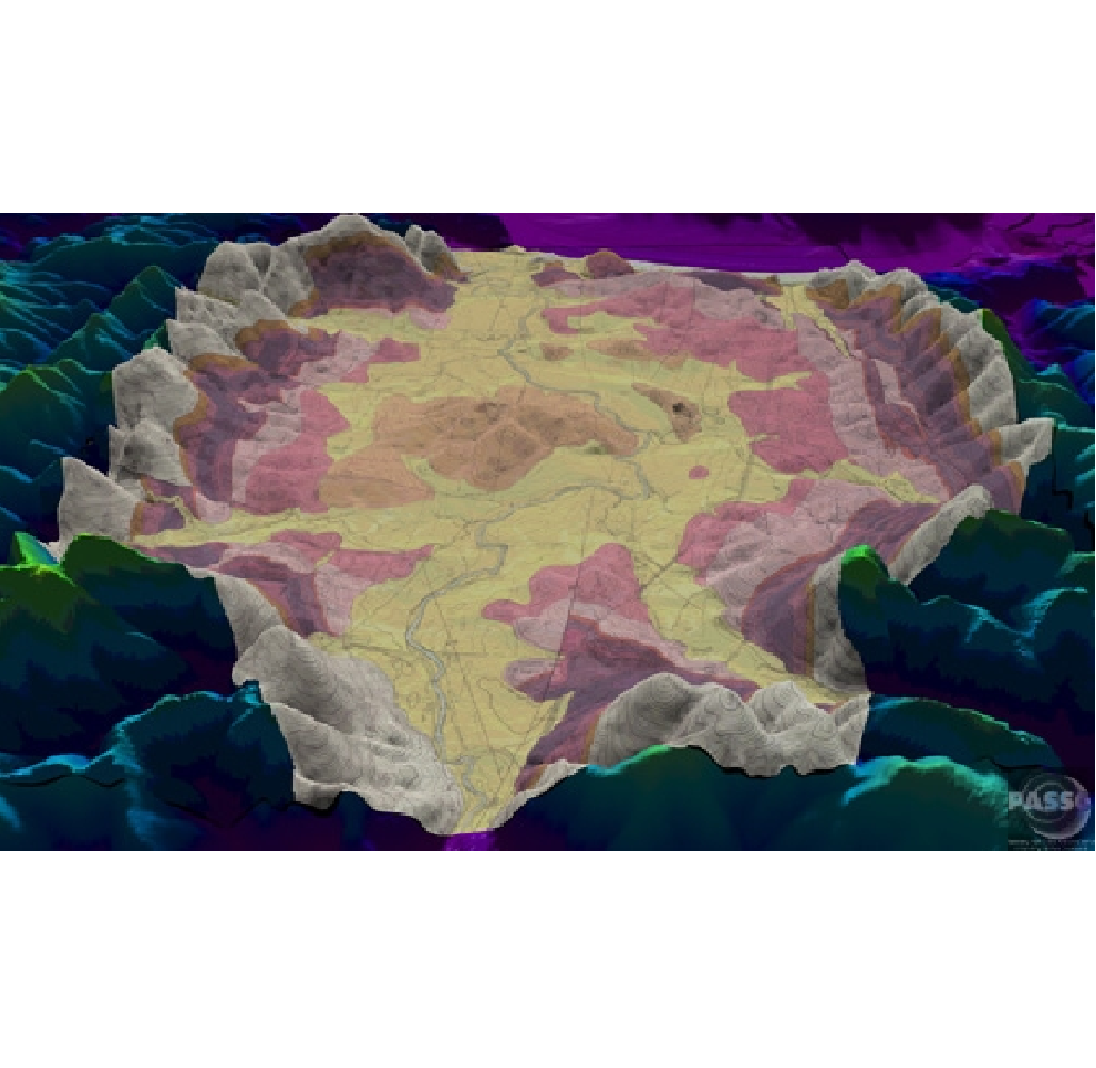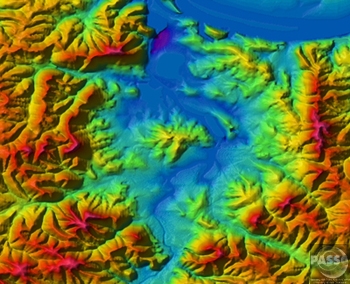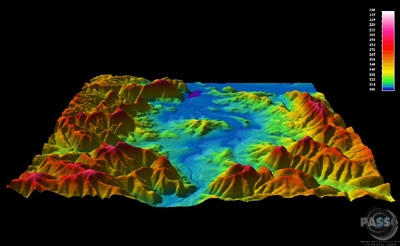Wells Creek
| Crater Name | Location | Latitude | Longitude | Diameter (km) | Age (Ma) | Exposed | Drilled | Target Rock** | Bolide Type*** |
|---|---|---|---|---|---|---|---|---|---|
| Wells Creek | Tennessee, U.S.A. | N 36° 23' | W 87° 40' | 12 | 200 ± 100 | Y | Y | S | - |
1. Geology on a Digital elevation model. View from south to north. Geology of central uplift is: Orange peak, yellow and dark pink areas at center are Lower to middle Ordovician Limestone. This material was thrust upwards a distance as much as 800m+/-. Light Pink through to orange are Silurian, Devonian and Mississippian strata. Middle Ordovician Strata and above are flanking a ring structure (seen as a topographinc high). Generated by Graham Nickerson at Interactive Visualisation Systems, Fredericton, New Brunswick
2 & 3. DEM
References |
Bucher, W. H., The largest so-called meteorite scars in three continents as demonstrably tied to major terrestrial structures. New York Academy of Sciences, Annals, v. 123, pp. 897-903. 1965. |
Bucher, W. H., Crypotexplosion structures caused from without or from within the Earth? American Journal of Science, v. 261, pp. 597-649. 1936. |
Bucher, W. H., Cryptovolcanic structures in the United States. 16th International Geological Congress, Report, v. 2, pp. 1055-1084. 1936. |
Grieve, R. A. F., The record of impact on Earth: Implications for a major Cretaceous/Tertiary impact event. Geological Society of America, Special Paper 190, pp. 25-37. 1982. |
Gurov, E. P., Gurova, E. P., Impact structures on the Earth's surface (in Russian). Geologicheskii Zhurnal, v. 47, pp. 117-124. 1987. |
Kellberg, J. M., Possible tectonic origin for "cryptoexplosion" structures: Wells Creek structure, Tennessee (abstract). Geological Society of America, Special Paper 87, p. 253. 1966. |
Khryanina, L. P., The structure of meteorite craters and their central uplifts (in Russian). Doklady Akademii Nauk SSSR, v. 238, pp. 195-198. 1978. |
Masaitis, V. L., Some old meteoritic craters on the territory of the USSR (in Russian). Meteoritika, v. 33, pp. 64-68. 1974. |
Milici, R. C., Manning, R.A. and Statleer,A.T., Oil and gas production from the Wells Creek and Knox dolomites (Ordovician), Buffalo Cove field, Fentress County, Tennessee (abstract). Abstracts with programs, p. 518. 1975. |
Milam K.A., Deane B., Petrogenesis of central uplifts in complex terrestrial impact craters, 2005. |
Skrynnik, G. V., Meteorite craters on the Earth (in Russian). Astronomicheskii Vestnik, v. 11, pp. 198-210. 1977. |
Stearns, R. G., Tiedemann, H.A. and Wilson, C.W.,Jr., Geologic map of the Needmore quadrangle, Tennessee. Tennessee Division of Geology, Geologic Map GM 38-NE. 1968. |
Stearns, R. G., Wilson, C.W., Jr., Tiedemann, H.A., Wilcox, J.T. and Marsh,P.S., The Wells Creek structure, Tennessee. French, B.M. and Short, N.M., eds., Shock Metamorphism of Natural Materials, Mono Book Corp., Baltimore, MD, pp. 323-338. 1968. |
Tiedemann, H. A., The Wells Creek structure, Tennessee - From Heaven or Hell?. Ames Structure in Northwest Oklahoma and Similar Features: Origin and Petroleum Production (1995 Symposium), K. S. Johnson and J. A. Campbell, Oklahoma Geological Survey, Norman, Oklahoma, v. Circular 100, pp. 265-271. 1997. |
Tiedemann, H. A., The Wells Creek structure -- from heaven or hell? (abstract). Ames Structure and Similar Features - a Workshop, pp. 13. 1995. |
Tiedemann, H. A., Wilson,C.W., Jr. and Stearns,R.G., Geologic map and mineral resources summary of the Cumberland City quadrangle, Tennessee. Tennessee Department of Conservation, Geologic Map GM 38-NW. 1968. |
Wilson, C. E.,Jr., Tiedemann, H.A. and Stearns,R.G., Meteor impact as a model for Wells Creek Basin (abstract). Geological Society of America Special Paper 101, p. 241. 1968. |
Wilson, C. W.,Jr., Stearns, R. G., Lateral and vertical movements of rock in the Wells Creek structure, Tennessee (abstract). Abstracts with programs, p. 87. 1975. |
Wilson, C. W.,Jr., Stearns, R. G., Circumferential faulting around Wells Creek basin, Houston and Steward Counties, Tennessee - a manuscript by J.M. Safford and W.T.Lander, about 1895. Tennessee Academy of Science Journal, v. 41, pp. 37-48. 1968. |
Wilson, C. W.,Jr., Stearns, R. G., Geology of the Wells Creek structure, Tennessee. Tennessee Division of Geology, Bulletin 68, 236 p. 1968. |
Wilson, C. W., Wilcox deposits in explosion craters, Stewart County, Tennessee, and their relations to the origin and age of Wells Creek Basin structure. Geological Society of America Bulletin, v. 64, pp. 753-768. 1953. |
Zotkin, I. T., "Moon" craters on the Earth (in Russian). Priroda, v. 9, pp. 95-105. 1969. |
| * pre-1977 K-Ar, Ar-Ar and Rb-Sr ages recalculated using the decay constants of Steiger and Jager (1977) Ages in millions of years (Ma) before present. ** Abbreviations: C - Crystalline Target; C-Ms - Metasedimentary Target; M - Mixed Target (i.e.sedimentary strata overlying crystalline basement); S - sedimentary target (i.e. no crystalline rocks affected by the impact event). From Osinski. G. R., Spray J. G., and Grieve R. A. F. 2007. Impact melting in sedimentary target rocks: A synthesis. In The Sedimentary Record of Meteorite Impacts, Geological Society of America Special Paper. Editors: Evans K. Horton W., King D., Morrow J., and Warme J. Geological Society of America: Boulder, in press. ***From Koeberl,C. Identification of meteoritic components in impactites. 1998, Koeberl, C. The Geochemistry and Cosmochemistry of Impacts. 2007 and PASSC Files. (IAB, IIIAB, IIIB, IIID - Iron Meteorite) |



